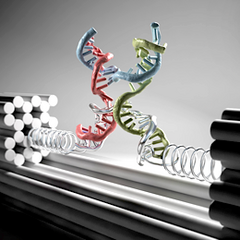Monday, 24 October, 2016
DNA-Based Force Spectroscopy Might Work in Living Cells
GEN News Highlight - October 24, 2016
In nanoscale dungeons, biomolecules are put on the rack, stretched until they divulge their mechanical properties, and whether or not they will continue to function as expected, even when subjected to structure-deforming stress. Unfortunately, nanoscale dungeons, like real dungeons, tend to be noisy places, which can confound analysis. Also, they are not terribly efficient. Microscale instruments of torture typically require a physical connection to the macroscopic world, and so they interrogate biomolecules just one at a time.
Yet torture at the biomolecular scale can be as creative as that at larger scales. Shunning instruments such as optical or molecular tweezers, scientists based at Ludwig-Maximilians-Universitaet (LMU) have instead resorted to DNA origami. These scientists, in collaboration with colleagues based at Technical University (TU) in Braunschweig and at Regensburg University, used single-stranded DNA molecules to fashion entropic springs that are capable of exerting controlled tension in the low piconewton range. Essentially, the scientists devised a new method of force spectroscopy that incorporates self-assembled nanoscopic power gauges, requires no macroscopic tools, and can analyze large numbers of molecules in parallel, which speeds up the process of data acquisition enormously.



 Read full article on GEN's homepage
Read full article on GEN's homepage